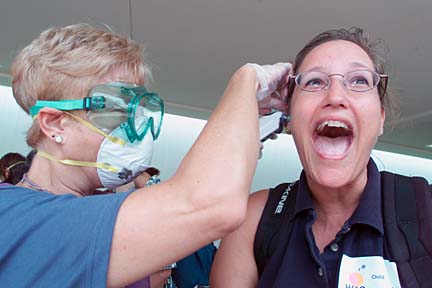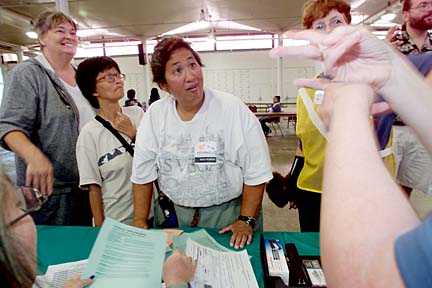

|
Mocking disaster
The state tests its response to a
bioterrorist attack involving the plague
Bentley Graves said he feels better about the state's ability to deal with a bioterrorist attack or natural disaster after participating in a mass drill yesterday.
"I figure if they're on top of it here, they are on the mainland," said Graves, 22, a summer intern from Iowa in Gov. Linda Lingle's office.
He was one of about 500 volunteers performing as patients in a medication clinic at the Neal Blaisdell Exhibition Hall. Some played different roles two or three times to represent about 1,000 patients.
Pneumonic plague, highly infectious and fatal if not treated early, was selected as the bioterrorism agent.
"We chose a very difficult scenario so we could really test all systems," said state epidemiologist Paul Effler.
The script covered the arrival of an airplane Saturday from Indonesia with passengers who had symptoms of the plague.

|
Graves said his role called for him to be screened because he came into contact with a person who was coughing. He was given a pretend bottle of doxycycline to take for 10 days.
As part of the exercise, Lingle said she called a Cabinet meeting to discuss the impact and steps to take. They drafted a proclamation asking the president to declare an emergency here.
"Yes, it's an exercise, but we are taking it very seriously," she said at a news briefing with her Cabinet officials. "It's as lifelike as we can make it."
Lingle said she called the U.S. Centers for Disease Control in Atlanta on a speaker phone Monday, also part of the exercise, "to convince CDC to send hundreds of thousands of medications to Hawaii."
Hawaii was one of 10 states chosen to receive a CDC training package, which arrived Tuesday with simulated antibiotics, vaccines, antidotes and other medical supplies.
Officials practiced doing an inventory and transporting and distributing the materials yesterday to the Blaisdell clinic and to a medication clinic conducted today at Maui Community College by the Maui District Health Office.
Effler said was "impressed" with the Honolulu exercise, which involved Red Cross, state and county Civil Defense officials, Honolulu police and representatives of state and federal agencies.
"The staff worked really hard," he said, especially commending Bart Aronoff, chief of the Health Department's Bioterrorism Preparedness Branch.
Effler said the exercise -- one of the most comprehensive in the nation -- improves the state's ability to respond to any pathogen coming into Hawaii, whether terrorism-related or not, such as severe acute respiratory syndrome (SARS) or West Nile virus.
CDC representatives were here to evaluate the exercise, which was intended to move 300 to 350 patients an hour through information, assessment and treatment procedures.
On Tuesday, hospitals on Molokai, the Big Island and Oahu "performed superbly" in an exercise to identify "first patients" with simulated symptoms of pneumonic plague, said Toby Clairmont, Healthcare Association of Hawaii emergency program manager.
Teams of two -- a sentinel patient and an observer -- went to about 16 hospitals participating in a bioterrorism preparedness exercise Tuesday, Clairmont said.
The hospitals also conducted an emergency operating exercise today, activating hospital command posts throughout the state.
Tuesday's exercise, part of a week-long hospital awareness campaign, was aimed at detecting and treating a patient with an infectious disease or bioterrorism agent before it triggers a major outbreak.
The hospitals did not know what organism to look for, and all but one identified it, Clairmont said. "One had to be coached."